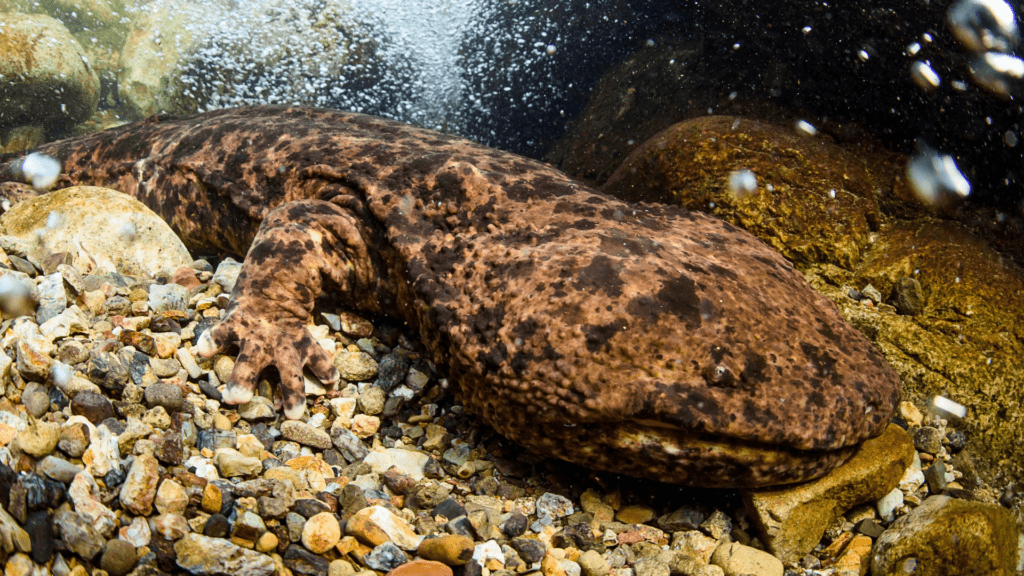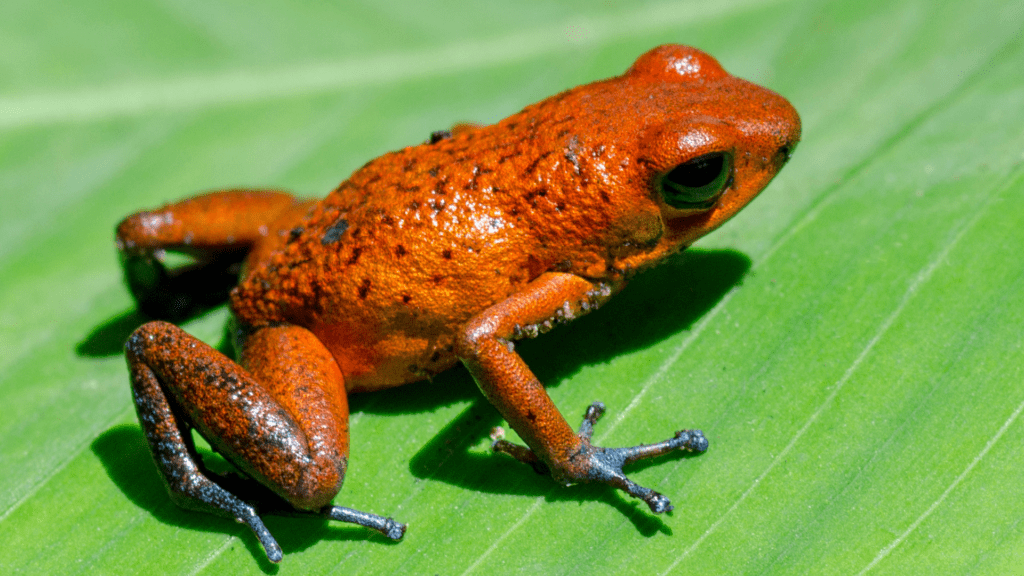
Pacific Tree Frog (Pseudacris regilla) is one of the smallest yet most vocal amphibians native to the West Coast of North America. This species, belonging to the Hylidae family, is easily recognizable by its toe pads, which help it cling to various surfaces. Due to its distinctive call, it is the most commonly heard frog in its natural habitat.
Scientific Classification
- Kingdom: Animalia
- Phylum: Chordata
- Class: Amphibia
- Order: Anura
- Family: Hylidae
- Genus: Pseudacris
- Scientific Name: Pseudacris regilla
Subspecies
There are three recognized subspecies
- Northern Pacific Tree Frog (Pseudacris regilla regilla)
- Sierran Tree Frog (Pseudacris regilla sierra)
- Baja California Tree Frog (Pseudacris regilla hypochondria)


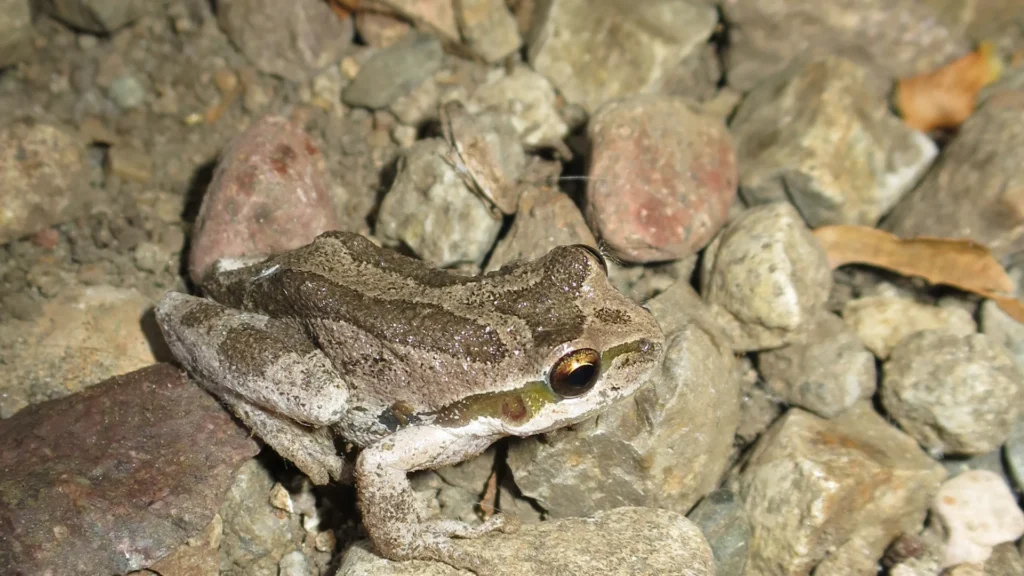
Physical Description
Pacific Tree Frog measures 3 to 4 cm in length and has various markings and spots on its back. Its upper body features small bumps, while its legs are relatively long and slender. Males can be distinguished by a dark patch on their throat.
A notable characteristic of this species is the rounded sticky pads at the bottom of each toe, allowing them to adhere to plants and other surfaces. Females are generally larger than males.
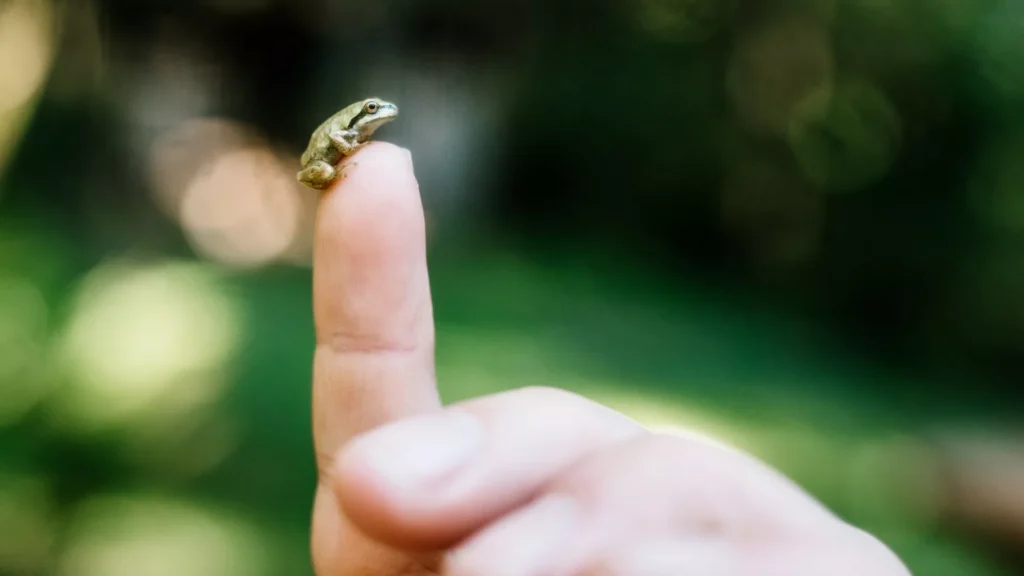
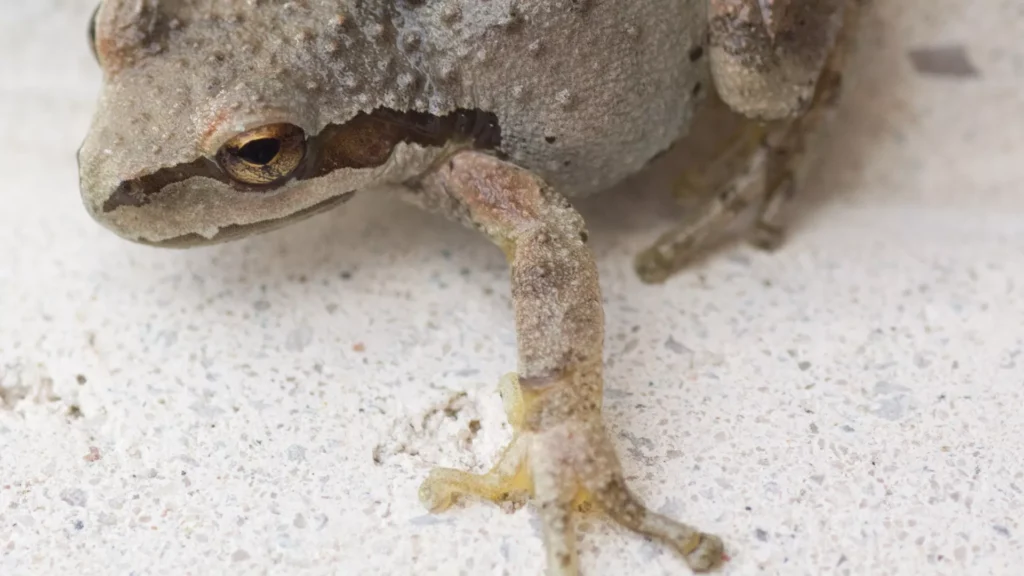
Coloration and Camouflage
These frogs primarily exhibit green and brown hues, but they have the ability to change color based on their surroundings for camouflage. They were initially thought to only be brown or green, but research has revealed additional shades such as cream, reddish cream, and reddish brown. Their underside remains creamy white.


Distribution and Habitat
Pacific Tree Frog is predominantly found along the West Coast of North America, including Oregon, Washington, British Columbia, and California. Its range extends eastward to Montana, Idaho, and Nevada and further north and south into parts of Canada, Alaska, and Mexico.
These frogs thrive in various habitats, including:
- Forests and woodlands
- Grasslands and pastures
- Semi-wild forests
- Streams, wetlands, and marshes
- Agricultural regions and residential areas
During colder months, they hibernate in burrows of small animals or dense vegetation.
Behavior and Diet
Pacific Tree Frog is primarily nocturnal and territorial. During breeding season, they gather in large numbers near breeding pools.
These carnivorous frogs feed mostly at night, but during mating season, they may feed throughout the day. Their diet includes:
- Flies
- Ants
- Mosquitoes
- Beetles
- Small spiders
They capture prey using their long, sticky tongue.
Reproduction and Lifecycle
Pacific Tree Frog reaches reproductive maturity at 18 months. Breeding occurs from November to July, depending on weather and location.
Common Breeding Sites
- Ditches and swamps
- Vegetated wetlands
- Wet meadows and marshes
- Streams with low currents
- Artificial and seasonal ponds
Male frogs migrate to breeding locations and produce loud calls to attract females. They may call from inside or outside the water, and compete with other males for mates.
Egg Laying and Tadpole Development
Females lay 450 to 800 eggs in small clusters (10-70 eggs per cluster) in shallow, calm water. These eggs exhibit UV-B radiation resistance and can survive mildly acidic and cold water for short periods.
After 2 to 3 weeks, the brown-colored tadpoles hatch. They have a long, round-shaped body and grow up to 2 inches. Their diet consists of:
- Plants and algae
- Small twigs
- Protozoa and bacteria
Metamorphosis takes 2 to 3 months, after which juveniles transition into their natural habitat.

Vocalization
Male Pacific Tree Frogs produce a diphasic call that sounds like “krrek..eek”, usually heard in the evening and night. During breeding season, males create a chorus, starting with a single frog and followed by others.
Lifespan and Predators
In the wild, these frogs live between 3 to 6 years. They are preyed upon by:
- Snakes
- Herons and birds
- Raccoons and minks
- American Bullfrogs
- Small reptiles and mammals
As Pets
Pacific Tree Frogs are popular pet amphibians, but keeping them requires a license. Typically, permits are granted to universities and research institutions.
Housing and Care
A large aquarium with both water and dry land is necessary. Essential elements include:
- Small plants and twigs for a natural habitat
- Pebbles at the aquarium bottom
- Temperature: 45-60°F
- Humidity: 70-75%
Diet
- Pacific Tree Frogs, when kept as pets, require a well-balanced diet to ensure their health and vitality. These amphibians are carnivorous, meaning they primarily consume a variety of small invertebrates. Providing the right types of food is crucial for their overall well-being, as it mirrors their natural diet in the wild.
- One of the most common food items for pet Pacific Tree Frogs is silkworms. These worms are soft, easy for the frogs to consume, and highly nutritious. They provide essential proteins and fats that support healthy growth and development.
- Another good option is butter-worms, which are high in fat content, making them an excellent energy source. However, they should be fed in moderation, as too many fatty foods can lead to obesity in amphibians.
- Earthworms are also a favorite for these frogs. Rich in protein and other nutrients, earthworms are a great way to provide variety in their diet. These worms are also easy to find and raise, making them a convenient option for frog owners.
- Mealworms are another common choice for feeding pet Pacific Tree Frogs. These worms are crunchy and provide a solid source of protein. They’re widely available and can be stored for longer periods, making them practical for feeding frogs over time.
- Crickets are perhaps the most widely recognized food for amphibians, and Pacific Tree Frogs are no exception. These active insects are a natural food source for many frog species in the wild. Crickets provide a healthy mix of proteins and other essential nutrients, and their movement makes them an exciting challenge for frogs to catch. Offering crickets can also encourage natural hunting behaviors and physical activity in your pet frog.
- It’s important to vary the diet of your Pacific Tree Frog to ensure that it receives a balanced mix of nutrients. A monotonous diet can lead to nutritional deficiencies, so including a range of these insects is beneficial for the frog’s overall health. Additionally, it’s essential to gut-load the insects before feeding them to your frog. This involves feeding the insects nutritious food so that when your frog eats them, it also receives the benefits of those nutrients.
- To further enhance the diet, occasional supplements of vitamins and minerals may be required, especially if you notice signs of malnutrition or poor health in your frog. Providing the right diet not only promotes good health but also helps your Pacific Tree Frog live a long and happy life in captivity
Interesting Facts
- In 2007, the Pacific Tree Frog was named the state frog of Washington, a recognition that highlights the species’ importance to the region’s natural heritage. This designation not only reflects the frog’s role in the local ecosystem but also emphasizes its connection to the state’s biodiversity.
- The Pacific Tree Frog’s remarkable sticky toe pads have caught the attention of researchers, particularly in the field of material science. Scientists have studied these toe pads to explore their potential applications in tire technology, seeking to replicate the frog’s ability to cling to surfaces in a variety of environments. This adaptation has sparked innovation in other fields as well, demonstrating the frog’s influence on modern design.
- In many Native American cultures, frogs, including the Pacific Tree Frog, are seen as symbols of transformation and spiritual connection. The belief that each frog corresponds to a human spirit is a reflection of the species’ cultural and spiritual significance across different communities.
- Beyond their cultural importance, these frogs play a vital role in indicating environmental health. Their sensitivity to pollutants makes them excellent bioindicators, alerting scientists and conservationists to potential dangers in the ecosystem. Changes in their population or behavior can often signal issues with water quality or habitat degradation, making their preservation crucial for maintaining ecological balance.
- The Pacific Tree Frog’s call, with its unique sound, has become an iconic feature in nature soundtracks and Hollywood movies. Its distinct “krrek…eek” call is often used as a background noise in films to evoke the feeling of the natural world, underscoring the frog’s role in both real and cinematic environments.
- Despite their widespread presence, it’s important to handle these frogs with care. Their skin contains salmonella, which can pose health risks if not properly managed. To protect both the frogs and humans, it’s advised to wear gloves when handling them.
Conservation Status
Despite their generally stable population across much of their range, the conservation status of the Pacific Tree Frog is influenced by several environmental challenges. While these amphibians remain relatively abundant, their numbers have seen declines in certain areas, primarily due to habitat loss and degradation. Human activities, such as urban development, agriculture, and deforestation, have significantly impacted the natural environments where these frogs thrive. Wetlands, forests, and other critical habitats have been altered or destroyed, leaving the frogs with fewer suitable areas to live and breed.
Additionally, the quality of the water in these frogs’ habitats is a growing concern. Pollution, runoff from agricultural lands, and climate change are contributing to the deterioration of wetland ecosystems, making them less hospitable for species like the Pacific Tree Frog. Changes in water temperature, pH, and pollution levels can negatively affect their breeding sites, leading to decreased reproductive success and, over time, population reductions.
However, despite these threats, the Pacific Tree Frog is currently classified as “Least Concern” (LC) on the International Union for Conservation of Nature (IUCN) Red List. This classification indicates that, overall, the species does not face an immediate risk of extinction. While localized declines may occur, the Pacific Tree Frog is still widespread and continues to occupy a variety of habitats across North America.
Conservation efforts are underway to ensure that these frogs continue to thrive. Habitat protection, wetland restoration, and pollution control measures are critical for maintaining the health of their ecosystems. By addressing the underlying causes of habitat destruction and pollution, there is hope that the Pacific Tree Frog’s population will remain stable and continue to play its important ecological role.
Despite their current status, ongoing monitoring is essential to track the species’ population trends. Conservationists remain vigilant in ensuring that the Pacific Tree Frog’s habitat is preserved and that future generations of these remarkable amphibians can enjoy a secure environment.
Final Thoughts
The Pacific Tree Frog is a remarkable amphibian with adaptive coloration, a distinctive call, and an important ecological role. Whether observed in the wild or studied in research, these small frogs continue to captivate scientists and nature enthusiasts alike.
faq’s
1. What family does the Pacific Tree Frog belong to?
The Pacific Tree Frog belongs to the Hylidae family.
2. How does the Pacific Tree Frog stick to surfaces?
It has rounded sticky pads on its toes that help it cling to plants and other surfaces.
3. What are the three subspecies of the Pacific Tree Frog?
Northern Pacific Tree Frog, Sierran Tree Frog, and Baja California Tree Frog.
4. How does the Pacific Tree Frog change color?
It changes color based on the environment to provide camouflage.
5. Where can the Pacific Tree Frog be found?
It is found in the West Coast of North America, including Oregon, Washington, British Columbia, and California.
6. What do Pacific Tree Frogs eat?
They eat flies, ants, mosquitoes, beetles, and small spiders using their long sticky tongue.
7. How many eggs does a female Pacific Tree Frog lay?
Females lay 450-800 eggs in small clusters attached to vegetation.
8. What is the average lifespan of the Pacific Tree Frog?
It typically lives 3 to 6 years in the wild.
9. Why is the Pacific Tree Frog important for the environment?
It serves as an indicator species for environmental health and pollution levels.
10. What unique feature of the Pacific Tree Frog is used in Hollywood movies?
Its distinctive call is widely used as a background sound in night scenes.
